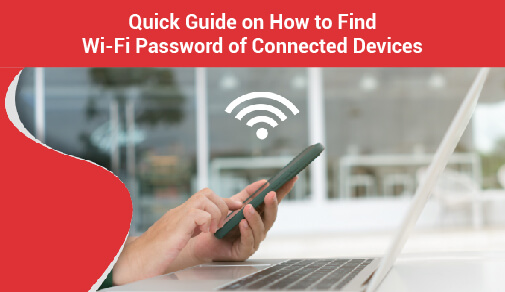wifi speed depends on the devices we use
-
0
-
-
10 minutes

In today's digital world, the importance of having a fast and reliable WiFi speed cannot be overstated. WiFi has become essential to people, enabling them to connect with others, access information, stream media, and conduct different online activities. Whether it is for work, entertainment, or staying connected with loved ones, a fast WiFi speed is essential to ensure a seamless and productive online experience.
When it comes to WiFi speed, multiple factors influence the ease of browsing and streaming capabilities. These factors include the quality of the internet speed, internet service provider, network congestion, bandwidth limitations, and the efficiency of the router and modem setup.
This article will navigate the impact of devices on WiFi speed and explore how different devices can either enhance or limit the internet speed of a WiFi connection. Read the full article and make informed decisions while selecting and using devices to maximise their internet speed.
Understanding WiFi Speed and Internet Speed
Many often confuse WiFi speed with internet speed and use them interchangeably. However, understanding the factors influencing WiFi speed is essential to differentiate between WiFi speed and internet speed.
WiFi speed vs. Internet speed
WiFi speed refers to the speed at which data is transmitted between the device and the router within the local network. On the other hand, internet speed refers to the rate at which data is exchanged between the router and the internet service provider (ISP).
WiFi network refers to the wireless connection between devices and routers, which then connects to the modem and, ultimately, to the internet. Therefore, the speed of the WiFi network and the speed of the Internet connection are not the same.
Suppose the WiFi speed is slower than the Internet speed. In that case, it means that wireless devices are not receiving the full speed of an Internet connection.
This is why ensuring that the WiFi network operates optimally is crucial to deliver fast and reliable internet access to all devices. By maintaining a fast WiFi network, users can ensure that all devices receive the full benefits of internet speed, enabling online activities such as smooth browsing, streaming, etc.
Factors Affecting WiFi Speed
WiFi speed is an integral component, and it is essential to recognise that its speed can be impacted by external factors beyond the scope of the local network.
To optimise WiFi speed, several factors must be considered:
Signal Strength and Obstacles
The closer device is to the router, the stronger the WiFi signal will be, resulting in higher data transfer rates. Physical obstructions such as walls and floors can weaken the signal, leading to slower speeds as users move farther from the router.
Other electronic devices operating on similar frequencies, such as cordless phones, neighbouring WiFi networks, etc., can cause interference and degrade WiFi performance.
Number of Users
Internet speed slowdowns can occur when there is a high volume of people attempting to connect to the internet simultaneously. These slowdowns are particularly noticeable during peak activity hours, such as in the evenings when people return home from work and try to access the web.
This increased demand for internet usage can strain the network infrastructure, resulting in reduced internet speeds for users.
WiFi Standards and Frequencies
WiFi operates on different standards, such as 802.11n, 802.11ac, or the latest 802.11ax (WiFi 6). These standards offer varying speeds and capabilities. Older devices may not support the latest standards and may experience slower WiFi speeds.
Additionally, WiFi networks operate on different frequencies (2.4GHz and 5GHz), each with advantages and limitations in speed and range.
Role of Devices in WiFi Speed
The type and number of devices connected to WiFi networks can significantly impact internet speed. These devices include smartphones, gaming consoles, tablets, laptops, and smart home devices. Understanding the role of these devices in WiFi speed is crucial for optimising internet connectivity and ensuring a smooth online experience.
The device's specifications can significantly impact the speed and performance of the WiFi connection. Here are some key specifications that can affect internet speed:
Network Interface Card (NIC)
The network interface card, or NIC, is responsible for connecting the device to the WiFi network. The NIC's type and quality can influence the WiFi connection's speed and stability. Devices with newer and more advanced NICs generally offer better performance than older devices with outdated ones.
WiFi Technology
Different WiFi technologies, such as 802.11n or 802.11ac, offer varying speeds and capabilities. Devices that support the latest WiFi technologies can achieve faster connection speeds and take advantage of advanced features, such as improved signal range and reduced interference.
Processing Power and RAM
The processing power and available RAM on a device can impact its ability to handle data-intensive tasks and maintain a stable WiFi connection. Devices with higher processing power and ample RAM can handle multiple data streams, and network requests more efficiently, resulting in better WiFi performance.
Network Congestion and Bandwidth Limitations
Network congestion can occur in scenarios where multiple devices are connected to the same WiFi network, leading to slower speeds. Additionally, some devices may have bandwidth limitations that restrict their maximum data transfer rates. These factors can collectively impact WiFi speed, especially during peak usage periods.
Device Age and Hardware Limitations
Older devices may have hardware limitations, such as weaker WiFi radios, limited antenna configurations, etc., that prevent them from achieving the same WiFi speeds as newer devices.
Older WiFi standards and outdated hardware components, such as slower processors, insufficient RAM (Random Access Memory) etc., can limit the maximum speed of a device.
Testing and Measuring WiFi Speed
There are several tools and methods available for measuring WiFi speed. Here are some of the most common ones:
Online Speed Test
Online speed tests are widely accessible tools that measure the download and upload speeds of internet connection. These tests provide a quick and convenient way to evaluate WiFi speed. Popular speed test websites include Ookla's Speedtest.net, Fast.com by Netflix, and Google's Internet Speed Test.
Dedicated WiFi Analyzer Tools
Dedicated WiFi analyser tools offer more comprehensive insights into the WiFi network's performance. They provide detailed information about signal strength, channel utilisation, and potential sources of interference. Some popular WiFi analyser tools include NetSpot, Acrylic WiFi, and WiFi Analyzer.
Factors to Consider During Speed Tests
When conducting speed tests, several factors should be considered to ensure accurate results:
Nearness to the Router
For reliable results, perform speed tests from different locations within the premises to assess the impact of distance on WiFi speed.
Interference
Ensure that no other devices or networks actively utilise the WiFi during the speed test to obtain more accurate results.
Testing Different Devices
Testing the WiFi speed on multiple devices can provide valuable insights into any potential variations or limitations that specific devices may have.
Optimising WiFi Speed for Devices
To optimise WiFi speed for devices, it is crucial to focus on router and network configurations. Consider the following steps for network configuration:
Placement of Router
The placement of routers plays a crucial role in enhancing internet speed. Follow the mentioned step for a better placement:
Step 1: Place the router centrally
Step 2: Ensure there is not any device or obstacle that may cause disturbance
Step 3: Adjust the router's antennas for optimal signal coverage and
Step 4: Experiment with their orientations to achieve the best signal strength
Channel Selection and Frequency Settings
WiFi routers operate on different channels within the available frequency bands. Use a WiFi analyser tool to identify the least congested channels in the area and adjust the router's channel settings accordingly. Additionally, if the router supports dual-band WiFi, utilise the 5GHz frequency band for less disturbance and faster speeds.
Upgrading Router Firmware
Regularly check for firmware updates provided by the router manufacturer. Updating the router's firmware ensures that the latest bug fixes, security enhancements, and performance optimisations, which can positively impact WiFi speed.
Device-specific Optimisations
Optimising WiFi speed also involves the following techniques:
Clearing Cache and Temporary Files
Accumulated cache and temporary files on devices can affect performance, including WiFi speed. Regularly clear these files to free up storage and ensure smoother function.
Disabling Unnecessary Background Processes
Background processes and applications can consume network resources, decreasing internet speeds. Identify and disable any unnecessary processes or applications running in the background that may be utilising the network unnecessarily.
Replace Network Card
If a device has an old or outdated network card, upgrading to a newer one can significantly improve internet speed and performance.
Adjust WiFi Settings
Users can adjust WiFi settings like channel width, transmit power, and antenna orientation depending on the device to optimise their connection.
Future Trends and Considerations
As technology continues to advance, emerging technologies are poised to significantly impact WiFi speed and performance. Consider the following trends:
WiFi 6 and Its Benefit
WiFi 6, also known as 802.11ax, is the latest WiFi standard designed to deliver faster speeds, increased capacity, and improved efficiency. With features like Orthogonal Frequency Division Multiple Access (OFDMA) and Multi-User Multiple Input Multiple Output (MU-MIMO), WiFi 6 can support higher data transfer rates, reduce latency, and provide better performance in dense environments.
The Potential Impact of 5G Networks
The rollout of 5G networks is expected to bring advancements in mobile connectivity. Still, it will also have implications for WiFi. With faster mobile internet speeds, users may rely less on WiFi networks for specific tasks.
However, 5G networks can complement WiFi by offloading data traffic, reducing network congestion, and allowing devices to switch between cellular and WiFi connections seamlessly.
Importance of Regular Device Upgrades
Regularly upgrading devices is essential to keep pace with evolving WiFi standards and increasing bandwidth demands. Consider the following points:
Supporting Newer WiFi Standards
Newer WiFi standards like WiFi 6 offer improved internet speed, better results, and enhanced network efficiency. To fully enjoy the benefits of these standards, it is crucial to upgrade devices to ones that support the latest WiFi technologies. Older devices with outdated hardware may not take advantage of the higher speeds and advanced features of newer WiFi standards.
Keeping up with Increasing Bandwidth Demands
With the proliferation of high-definition video streaming, online gaming, and other data-intensive activities, the demand for higher bandwidth continues to rise. Upgrading devices ensure they can handle the increasing bandwidth requirements, allowing for smoother and faster WiFi experiences.
This is particularly important in households or workplaces with multiple devices accessing the WiFi network simultaneously.
Final Words
The type of device individuals can impact WiFi speed to some extent, and it's just one of several factors that can affect internet performance. To optimise the internet experience, choosing a reliable ISP, using a high-quality router, and ensuring devices are up-to-date and positioned close to the router are crucial.
By measuring WiFi speed using online tests or dedicated analyser tools, users can assess the performance and make informed decisions about improvements. As technology advances, staying knowledgeable about emerging trends and considerations is crucial. WiFi 6 and the impact of 5G networks are shaping the future of WiFi speed, offering faster speeds, increased capacity, and improved performance.
To experience the benefits of a fast and reliable WiFi connection, explore the offerings of ACT Fibernet.
The cutting-edge technology and high-speed internet solutions provide the seamless connectivity you desire for My WiFi Speed and My Phone Internet Speed. Upgrade devices, optimise the network, and embrace the future of connectivity with ACT Fibernet.
Contact ACT Fibernet today!
FAQs
Why is my WiFi speed slower than my internet speed?
WiFi speed can be slower than internet speed due to various factors such as signal interference, distance from the router, and outdated devices. Additionally, WiFi connections are shared among multiple devices, leading to potential congestion and reduced speeds.
How can I improve my WiFi speed without upgrading my internet plan?
You can improve WiFi speed by optimising your router placement, reducing signal interference, and upgrading your router's firmware. Additionally, ensuring devices are up to date, clearing the cache, and disabling unnecessary background processes can enhance WiFi performance.
Does the type of device I use affect my WiFi speed?
Yes, the type of device you use can impact WiFi speed. Older devices with outdated hardware components, such as limited RAM, may not support the latest WiFi standards or handle high-speed connections as effectively as newer devices.







